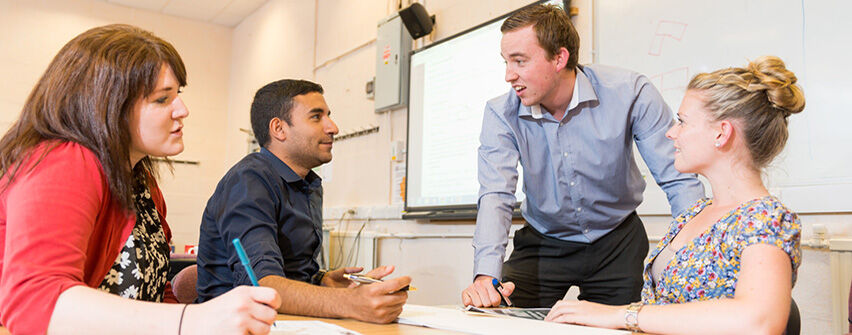The DigiDoc team starts 2022 moving into the next planning stage of the international ‘digital doctorate’, the EdD-I: developing the curriculum and the international supervision process. In this blog we reflect on a 'conceptual mapping' workshop we carried out as part of the project to support the development of a canon of reading for the EdD-I. Whilst the traditional Western literary canon has historically been rooted within hierarchical dividing practices, predominantly comprising white, male, Western writers, we instead root our thinking in theories of the ‘posts’, such as postcolonial theory, to develop a new canon that is unique to DigiDoc. The composition of the DigiDoc canon will be inclusive and diverse, including empirical research and wider literature from across China, Indonesia, Vietnam, and the UK in multilingual and multimodal formats.
Carolyn Blackburn, Chun Cao, Pham Thi Thanh Hai, Tan Huynh, Le Thi Thu Lieu, Louise Wheatcroft
Research cartographies
Through the visual mode of mapping, we each shared some of the key thinkers and concepts that have been important in our research and teaching journeys to-date. The process of visual map-making to represent research cartographies is open-ended and can take diverse forms: opening up space for in-the-moment ideas, visual metaphors, and as a tool for exploring complexities and alternative forms of representations. Haraway describes maps a ‘both instruments and signifiers of spatialization’ (1997: 135), whilst Hernández-Hernández et al. refer to maps as an ‘apparatus of capture’ that ‘territorializes the new and the singular and can show assemblages’ (2018: 107-108). ‘Assemblage’ is a useful term in this process, emanating from the work of Deleuze and Guattari (1988), capturing the open-ended and contemporaneous nature of ideas, connections, bodies, and affective relations.
Reconsidering our conceptual mapping activity as a ‘research-assemblage’ takes us beyond solely the text that shows the names of theorists and their key concepts and invites us to explore meanings through the visual aspects such as signposting and representations of non-linear messiness. Important also in this process, and what is less easy and evident to capture on the paper, are how those concepts made you feel at different stages of your research journey or how they connected to wider spaces, and more abstract aspects, that were also important parts of the research process.
Below we capture some of the research cartographies from across the DigiDoc team shared in the workshop and reflect on some of the ‘thinking behind the doing.’
Mary-Rose Puttick, Birmingham City University, UK
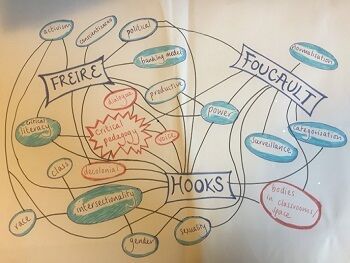
In the process of drawing my own conceptual map as an example to demonstrate the workshop activity, I struggled to know where to start. I had explored so many theories and concepts for my PhD and some had caused me such feelings of anxiety at different stages of my doctoral journey that I wasn’t sure I was ready to revisit them yet! I decided to choose three that had been my grounding theorists right from the start and that I had returned to as a kind of ‘safety net’: Paulo Freire, bell hooks, and Michel Foucault. These three thinkers were also interconnected with my teaching on the MA Education Critical Pedagogy module so they felt familiar and friendly. As my map emerged, I started to think in new ways about how these theorists were connected through the concepts of ‘power’ and ‘identity’, and to reflect on what this meant in terms of my research interests on women’s literacy practices, voice, and participatory research. Visual mapping has always been an important part of my thinking process and I like the way that each time you revisit the maps they stimulate new questions, ideas, and lead you into new areas of reading.
Louise Wheatcroft, Birmingham City University, UK
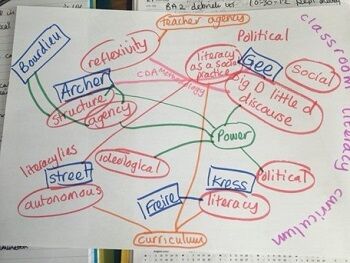
My map shows in blue some of the authors whose ideas informed my research around student teachers’ decision-making in classrooms when using digital tools to teach literacy. In red are some of the key themes that arose from reading the literature around literacies, curriculum, and classroom spaces. I used Archer’s ideas on reflexivity and Gee’s discourse analysis to help me to explore structure and agency in literacy classrooms.
Pham Thi Thanh Hai, Vietnam National University, Vietnam
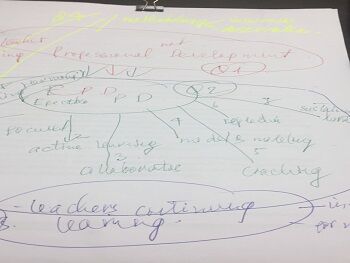
My map represents my research on ‘Professional Learning’. I carried out my research through observations and interviews and the lemon colour on the map presents these methods. Continuous Professional Development (CPD) is a central keyword, presented in red. I have written some of my important CPD research concepts in green that required special attention in the research process such as, ‘active’, ‘focused’, ‘collaborative’, ‘module and modelling’, and ‘reflection’. Finally, my map shows that professional learning is carried out in two forms, formal and informal, with the two formats written in navy.
Chun Cao, North East Normal University, China
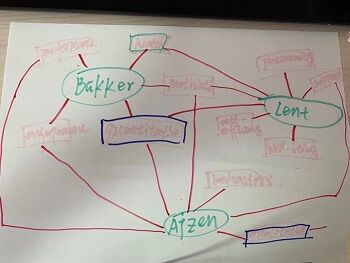
This cartography describes the theories often used to guide my research on university academics’ occupational well-being, motivation, and professional development. The green colour represents key contributors of the theories, such as Bakker et al.’s ‘Job Demands and Resources Model’, Ajzen et al.’s ‘Theory of Planned Behaviour’ and Lent et al.’s ‘Social Cognitive Career Theory’. The pink colour linking these key thinkers, represents the major outcomes of academics that have been revealed with the guidance of these theories. Finally, the blue colour represents prior literature regarding which research method (quantitative and/or qualitative) can be employed in utilising these theories.
Le Thi Thu Lieu, Ho Chi Minh City University of Education, Vietnam
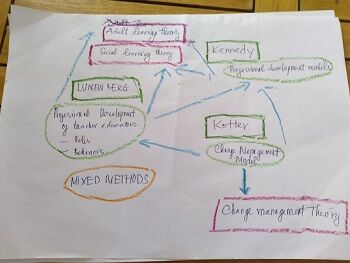
My map represents an overview of my PhD thesis, which is about policies for professional development for teacher educators in universities of education. Adult learning and social learning theories are two of the main conceptual frameworks I am using for my thesis: represented on my map in pink. Some of the key theorists for my research are shown on the map in green boxes. For example, to explore the types of professional development the lecturers in my research are engaged in, I am applying the professional development model of Kennedy, and to examine the management of professional development of higher education teacher educators, I am using Kotter’s change management model. I have also included on my map a book that has been very useful in developing my knowledge for my thesis. The orange circle on the map shows the mixed methods approach I am utilising for my study, including surveying and interviewing teacher educators, including those at different management levels.
Tan Huynh, Nguyen Tat Thanh University, Vietnam
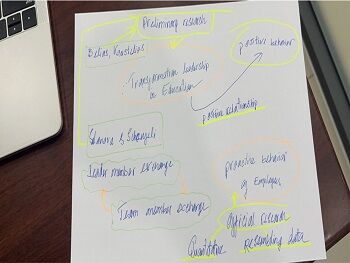
My research integrates the relational approach and social exchange theory, through which I am conceptualising the quality of leader member and team member exchanges as mediators for understanding the role of transformational leadership in employee proactive behaviours in the university. ‘Transformational leadership’, ‘proactive behaviour’, and ‘positive behaviour’ are terminologies that help me find breakthroughs in creating their own advantages in the university context. These key concepts, and some important theorists that have supported my research approach, are represented on my map. I have been spending time finding out that proactive behaviour does not just come from the staff, but rather is a complex process that arises from the combination of the ‘Team Leader’s’ behaviour, and the quality of the ‘Leader-Member Exchange’ and the ‘Team Member Exchange’: my map acts as a visual explanation of this process.
Carolyn Blackburn, Birmingham City University, UK
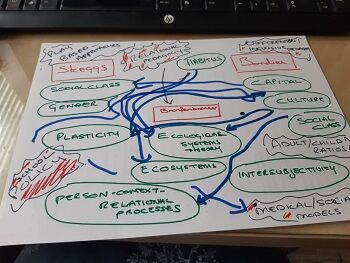
My map revisits my PhD research which focused on the communicative interactions of young children with special educational needs and English as an additional language within the context of early years care and education. For my PhD I used ecological systems theory as an analytical framework, and my map shows how the intersubjective and relational nature of early language development drew attention to the role of proximal processes within the micro systems of home and early years settings and the ‘relationships between’ at the meso level. My findings highlighted the gendered nature of early care and education and cultural and social capital of parents in seeking guidance and support for their child’s development. My interest and fascination with these concepts continue, becoming a constant reassurance and companion in my research since my doctorate, but I am constantly seeking new ways to challenge my thinking and find different lenses through which to reflect on research findings.
References
Deleuze, G., & Guattari, F. (1988). A thousand plateaus. London: Athlone
Haraway, D. (1997). Modest Witness @ Second Millennium. Femaleman meets Oncomouse. New York, NY: Routledge.
Hernández-Hernández, F., Gil, J.M.S. and Domingo-Coscollola, M., 2018. Cartographies as spaces of inquiry to explore of teachers’ nomadic learning trajectories. Digital Education Review, pp.105-119.

